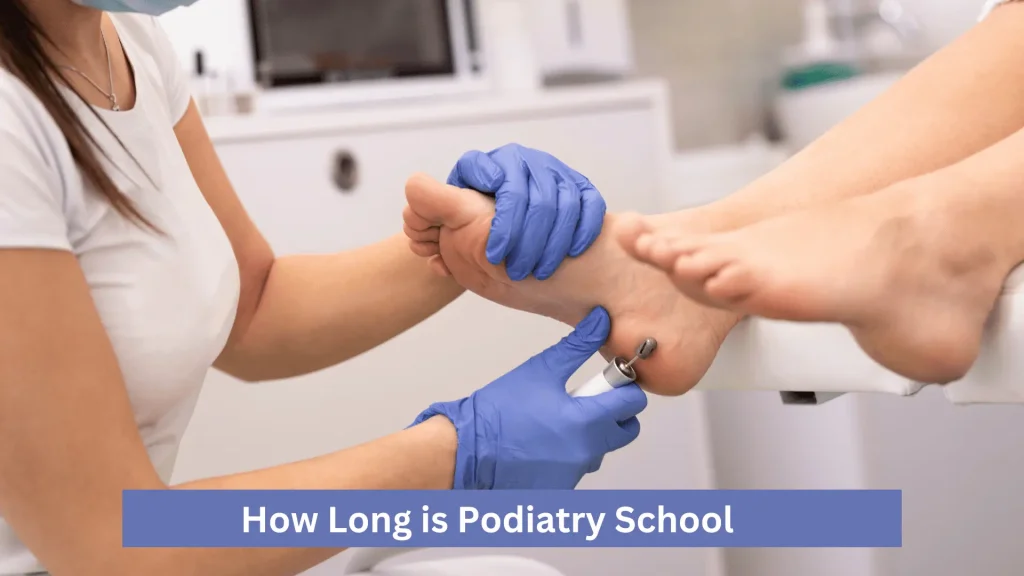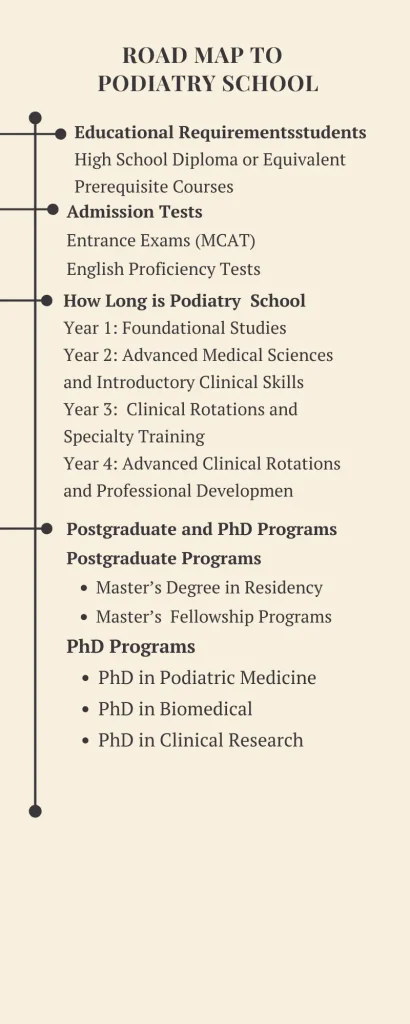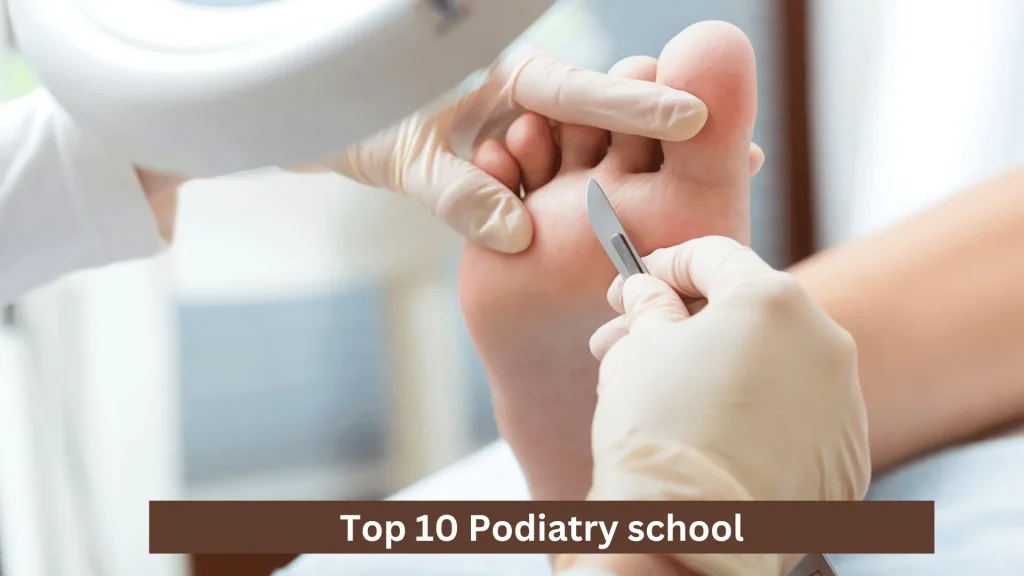How Long is Podiatry School
How Long is Podiatry School? Podiatry school typically takes four years to complete. During this time, students undergo rigorous training in foot and ankle care, including both medical and surgical treatments. Following graduation, a three-year residency is often required. In total, the path to becoming a podiatrist can take up to seven years.
What is Podiatry School
Podiatry school is a specialized medical program focused on diagnosing and treating conditions of the foot, ankle, and lower extremity. Students in podiatry school receive comprehensive education in areas such as anatomy, physiology, pathology, pharmacology, and biomechanics, equipping them with the skills necessary to provide medical and surgical care for various foot and ankle disorders.

In addition to classroom learning, podiatry students undergo extensive clinical training. This hands-on experience allows them to apply their knowledge in real-world settings, treating patients under the supervision of experienced podiatrists. Podiatry school prepares graduates to manage a wide range of conditions, from common foot ailments to complex surgical procedures.
How Long is Podiatry School
Year 1: Foundations
In the first year of podiatry school, students focus on foundational medical sciences. Courses typically include anatomy, physiology, biochemistry, and pathology, along with introductory podiatry-specific subjects like lower extremity anatomy and podiatric biomechanics. This year establishes the core knowledge required for clinical practice.
Year 2: Advanced Medical Sciences and Introductory Clinical Skills
The second year delves deeper into advanced medical sciences and begins to incorporate clinical skills. Students take courses in pharmacology, microbiology, and systemic pathology, while also starting hands-on training in podiatric assessment and diagnosis. This year often includes supervised clinical experiences to begin applying theoretical knowledge.
Year 3: Clinical Rotations and Specialty Training
In the third year, students spend a significant amount of time in clinical rotations, gaining practical experience in various healthcare settings. Rotations may include general podiatric medicine, surgery, orthopedics, and wound care. This hands-on training is crucial for developing clinical skills and understanding the scope of podiatric practice.
Year 4: Advanced Clinical Rotations and Professional Development
The final year focuses on advanced clinical rotations and professional development. Students refine their skills in specialized areas such as pediatric podiatry, sports medicine, and diabetic foot care. They also prepare for board exams and residency applications. This year is designed to ensure graduates are fully prepared for professional practice and further training in a residency program.

How to Enter Podiatry School
Educational Requirements
Bachelor’s Degree: Most podiatry schools require applicants to have a bachelor’s degree, typically in a science-related field.
Prerequisite Courses: Common prerequisites include biology, chemistry, physics, and anatomy. Some programs may also require courses in psychology, mathematics, and English.
GPA Requirements: A competitive GPA, usually around 3.0 or higher, is often required for admission.
Entry Tests
Medical College Admission Test (MCAT): The MCAT is the standard entry test for podiatry school. It assesses knowledge in biological and physical sciences, as well as critical thinking and problem-solving skills.
Alternative Tests: Some schools may accept the GRE, though this is less common.
Application Process
Centralized Application Service: Applications are often submitted through the American Association of Colleges of Podiatric Medicine Application Service (AACPMAS).
Application Components:
Personal Statement: A written essay explaining the applicant’s motivation for pursuing podiatry.
Transcripts: Official academic transcripts from all post-secondary institutions attended.
Letters of Recommendation: Typically 2-3 letters from professors or healthcare professionals.
Extracurricular Activities: Documentation of relevant experiences, such as volunteer work, research, or clinical exposure.
Interviews: Selected candidates are invited for interviews, which may include both traditional and behavioral interview questions.
Financial Aid
Federal Student Aid: Podiatry students can apply for federal loans through the Free Application for Federal Student Aid (FAFSA).
Direct Unsubsidized Loans: Available to graduate and professional students.
Direct PLUS Loans: Additional funding options for students needing more than the unsubsidized loan limit.
Scholarships and Grants: Various scholarships and grants are available through podiatry schools, professional organizations, and private foundations.
Merit-Based Scholarships: Awarded based on academic performance and achievements.
Need-Based Grants: Provided to students demonstrating financial need.
Work-Study Programs: Some schools offer work-study opportunities that allow students to earn money while gaining relevant experience.
Loan Repayment Programs: Programs such as the National Health Service Corps (NHSC) offer loan repayment assistance for podiatrists working in underserved areas.
These components together help aspiring podiatrists navigate the educational and financial landscape of podiatry school.
Post Graduate and PhD Programs
Post Graduate Programs for Podiatry
1. Residency Programs
Duration: Typically 2-3 years.
Focus: Advanced clinical training in podiatric medicine and surgery.
Specializations: Options may include podiatric surgery, sports medicine, wound care, and diabetic foot care.
Certification: Completion of residency programs qualifies graduates for board certification in podiatric medicine and surgery.
2. Fellowship Programs
Duration: 1-2 years, following residency.
Focus: Specialized training in areas such as reconstructive foot and ankle surgery, sports medicine, or advanced diabetic foot care.
Purpose: To gain expertise in a specific area of podiatric practice and contribute to advanced research or clinical techniques.
3. Board Certification
Certifying Boards: American Board of Podiatric Medicine (ABPM) and American Board of Foot and Ankle Surgery (ABFAS).
Requirements: Passing written and oral examinations. Board certification is often required for hospital privileges and certain professional positions.
PhD Programs for Podiatry
1. PhD in Podiatric Medicine or Related Fields
Duration: Typically 3-5 years.
Focus: Advanced research in podiatric medicine, biomechanics, pathology, or related fields.
Program Structure:
Coursework: Advanced courses in research methodology, statistics, and specialized topics in podiatry.
Research: Conducting original research leading to a dissertation.
Defense: Presentation and defense of research findings before a committee.
2. PhD in Biomedical Sciences
Duration: Typically 4-6 years.
Focus: Broader research in biomedical sciences with applications to podiatry.
Program Structure: Includes coursework in advanced biomedical topics, research methods, and a dissertation related to foot and ankle health or related areas.
3. PhD in Clinical Research
Duration: 3-5 years.
Focus: Research on clinical practices, outcomes, and innovations in podiatry.
Program Structure: Coursework in clinical research methods, data analysis, and a dissertation based on clinical studies in podiatry.
These programs provide opportunities for podiatrists to further their expertise, engage in advanced research, and contribute to the field’s development.
Top 10 Podiatry Schools

Here are some of the top podiatry schools in the U.S., known for their quality of education, research opportunities, and clinical training:
1.New York College of Podiatric Medicine (NYCPM)
Location: New York, NY
Highlights: One of the oldest and most established podiatry schools with a strong focus on clinical training and research.
2.California School of Podiatric Medicine at Samuel Merritt University (CSPM)
Location: Oakland, CA
Highlights: Known for its comprehensive podiatric curriculum and commitment to community health.
3.Temple University School of Podiatric Medicine (TUSPM)
Location: Philadelphia, PA
Highlights: Offers extensive clinical training and is affiliated with a major health system for hands-on experience.
4.Barry University School of Podiatric Medicine
Location: Miami Shores, FL
Highlights: Provides a diverse clinical experience and emphasizes research and community service.
5.Des Moines University College of Podiatric Medicine and Surgery (DMU-CMP)
Location: Des Moines, IA
Highlights: Offers a comprehensive curriculum with strong clinical and research components.
6.Kent State University College of Podiatric Medicine (KSUCPM)
Location: Independence, OH
Highlights: Known for its rigorous academic program and clinical training.
7.School College of Podiatric Medicine at Rosalind Franklin University
Location: North Chicago, IL
Highlights: Offers a broad-based medical education with a strong focus on research and clinical practice.
8.Western University of Health Sciences College of Podiatric Medicine
Location: Pomona, CA
Highlights: Emphasizes a holistic approach to podiatric education and provides diverse clinical opportunities.
9.University of Texas Health Science Center at San Antonio (UTHSCSA) – School of Podiatry
Location: San Antonio, TX
Highlights: Provides extensive clinical training and research opportunities in podiatric medicine.
10.Midwestern University Chicago College of Podiatric Medicine (CCPM)
Location: Downers Grove, IL
Highlights: Known for its collaborative approach to education and strong clinical training programs.
These schools are renowned for their programs, faculty, and facilities, providing a solid foundation for future podiatrists.
Factors Affecting the Length of Podiatry School
1. Program Structure
Curriculum Design: The length of podiatry programs can vary based on whether the curriculum includes additional courses or integrated training. Some programs may offer accelerated tracks or extend training to include more comprehensive clinical experiences.
Clinical Rotations: The number and duration of required clinical rotations can affect the overall length of the program. More extensive clinical training can add time to the program.
2. Residency Requirements
Duration: After completing podiatry school, graduates typically enter a residency program lasting 2-3 years. The length of the residency can impact the total time needed to become a fully licensed podiatrist.
Specialization: Some graduates choose to pursue additional fellowships in specialized areas, which can extend the total training period.
3. Full-Time vs. Part-Time Enrollment
Full-Time Study: Most podiatry students attend programs on a full-time basis, completing the required coursework and clinical training within the standard 4-year timeframe.
Part-Time Study: Some students may attend part-time or take extended leave, which can lengthen the duration of their studies.
4. Academic Performance
Course Load: Students who need to retake courses or who are placed on academic probation may face extended study periods.
Progression: Delays in completing coursework or clinical requirements can also affect the overall length of the program.
5. Personal Circumstances
Health Issues: Personal health problems or family responsibilities can impact a student’s ability to complete the program on time.
Financial Constraints: Financial difficulties may require students to take on part-time work or reduce their course load, potentially extending the duration of their studies.
6. Accreditation and Licensing
Program Accreditation: Ensuring that the program meets accreditation standards may influence the length of the curriculum, as some programs may incorporate additional components to meet accreditation requirements.
Licensing Requirements: Meeting state or national licensing requirements may involve additional steps or examinations that can impact the timeline for becoming a licensed podiatrist.
7. Institutional Variations
School Differences: Different podiatry schools may have varying structures and lengths for their programs. Some may offer more integrated or accelerated options, while others may have a more traditional approach.
These factors collectively influence the overall length of time required to complete podiatry school and enter the professional field.
Final Verdict
The length of podiatry school can vary based on program structure, residency requirements, and personal circumstances. Understanding these factors helps prospective students plan effectively for their educational journey in podiatry.
FAQs
1.How long does podiatry school take?
Typically four years, followed by a 2-3 year residency program.
2.What are the prerequisites for podiatry school?
A bachelor’s degree with coursework in sciences, a competitive GPA, and passing the MCAT.
3.What tests are required for admission to podiatry school?
The MCAT is the primary test, though some programs may accept the GRE.
4.What financial aid options are available for podiatry students?
Federal loans, scholarships, grants, and work-study programs can help finance education.
5.What is the difference between a residency and a fellowship in podiatry?
Residency provides general training; a fellowship offers advanced specialization in a specific area.
